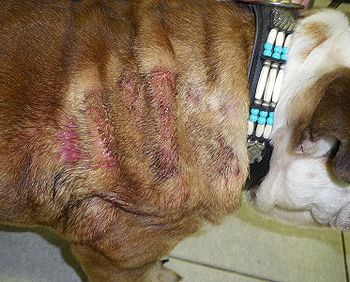
Dog Hot Spots
Veterinarian Reviewed on June 17, 2012 by Dr. Janice Huntingford
Dog Hot Spots
Signs and Symptoms
Canine hot spots can be very frustrating, both for the dog and the owner who can’t bear to see their furry friend uncomfortable or in pain. If your pooch has a hot spot then you will see how they gnaw away at a part of their body until they cause an open sore, bleeding and infection if not seen to by a veterinarian. By closer observation you might notice pus leaking from the wound which could only imply that an infection already exists.
We know it as a hot spot, but the medical term for this infection is pyotraumatic dermatitis. Whatever you choose to call it, the infection is commonly found on the surface of the skin and happens due to an abnormal amount of skin bacteria. It can be very irritating for the dog who will try to ease the irritation through excessive licking and nibbling. The hairs will fall out and swelling will occur. It isn’t life-threatening, but shouldn’t be ignored as it can spread and change the behavior of your dog who might even attack if you come too close to the sore spot.
Seemingly appearing out of the blue, a hot spot can develop on all breeds of dogs. There tend to be more cases though in dog breeds with long, thick hair and a medical history of Dog Allergies. Hot spots can appear in various parts of the body but tend to be found on the limbs and by the feet.
How Can Hot Spots Be Treated?
On accessing your dog’s irritation and coming to the conclusion that he or she has a hot spot you must approach the treatment in two ways.
First and foremost, you should address the sore directly and then figure out what is the cause of the infection and what action is needed to stop it from re-appearing in the future. You might prefer to go straight to your veterinarian who can advise you, but there are some things that you can do at home too.
To see the extent of the damage done you should carefully trim the hairs away from around the sore. Doing this will also help to stop the infection from becoming worse as it is through the hairs that it can disperse. Following this, it is perfectly safe to wash the area using an antiseptic soap and cotton pads. If after washing with the antiseptic, the wound doesn’t improve or heal, then visit your vet for a prescription of antibiotics and an Elizabethan collar so your dog can’t interfere with the healing process.
How To Prevent Hot Spots
Preventing hot spots might be as simple as grooming your dog on a regular basis to stop dead hairs and skin getting matted into the fur. As well as combing out knots, you might have to trim the hair if it is particularly long and has a habit of tangling.
It might be that the root cause of the hot spot was down to Dog Fleas or Dog Flea Allergy Dermatitis, in which case you need to apply flea treatment once a month and work out with your vet how to define what factors are causing an allergy trigger.
It can even happen that a dog is just an excessive licker or nibbler without an underlying problem – supply them with plenty of toys and make sure they are getting out and about for walks and plenty of exercise.
Sign up for our newsletter and receive more articles and the latest pet health updates and special offers.
Our Expert
 Dr. Janice Huntingford
Dr. Janice HuntingfordJanice Huntingford, DVM, has been in veterinary practice for over 30 years and has founded two veterinary clinics since receiving her Doctor of Veterinary Medicine at the Ontario Veterinary College, University of Guelph. She has studied extensively in both conventional and holistic modalities. Ask Dr. Jan

